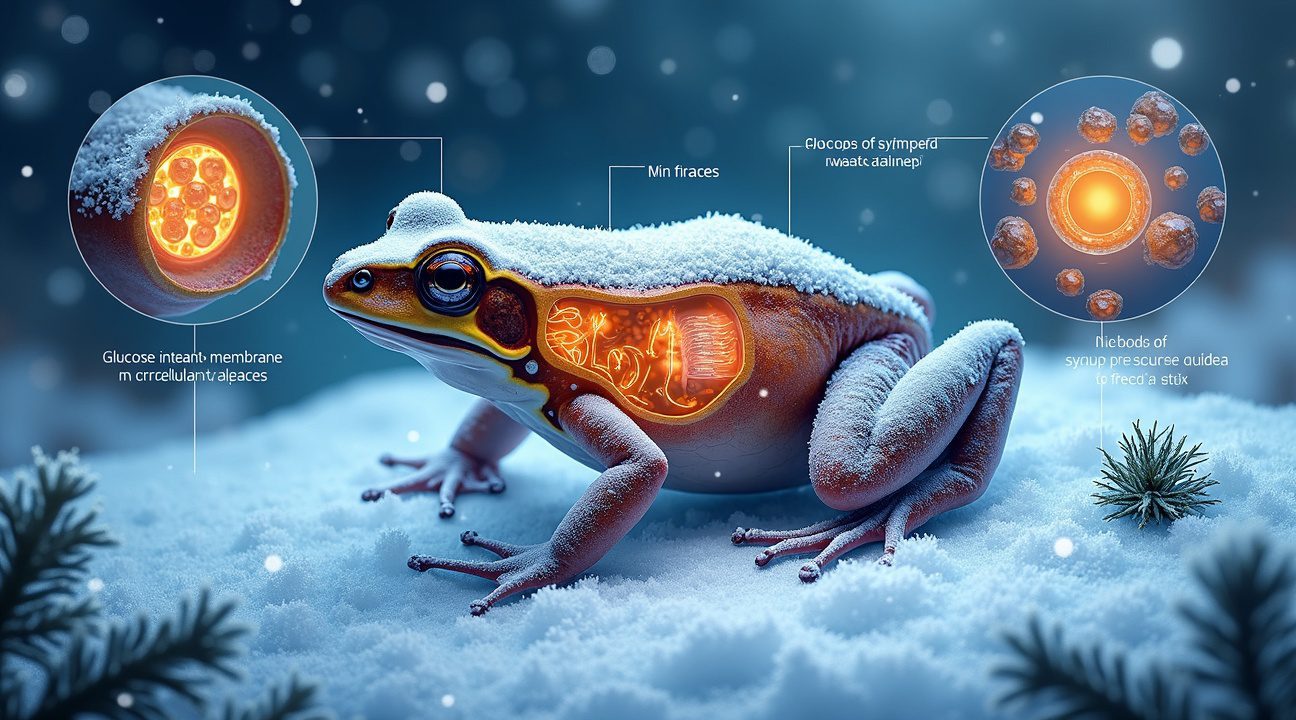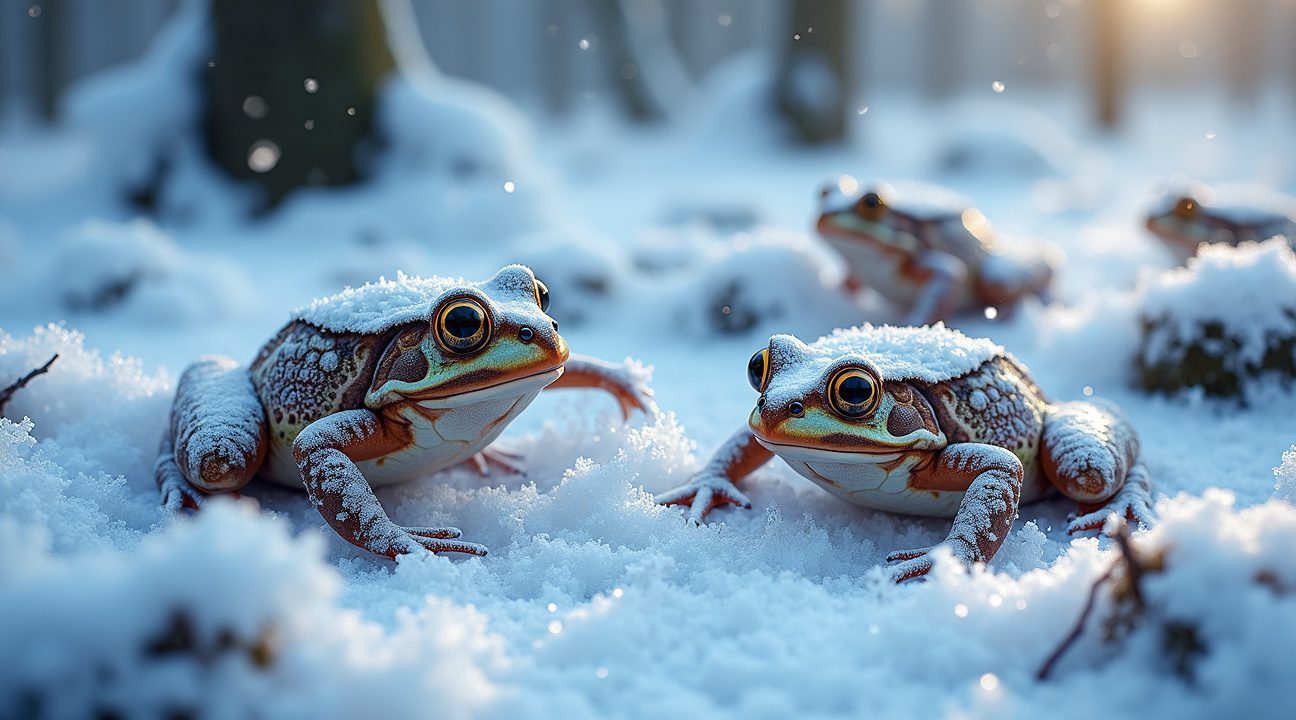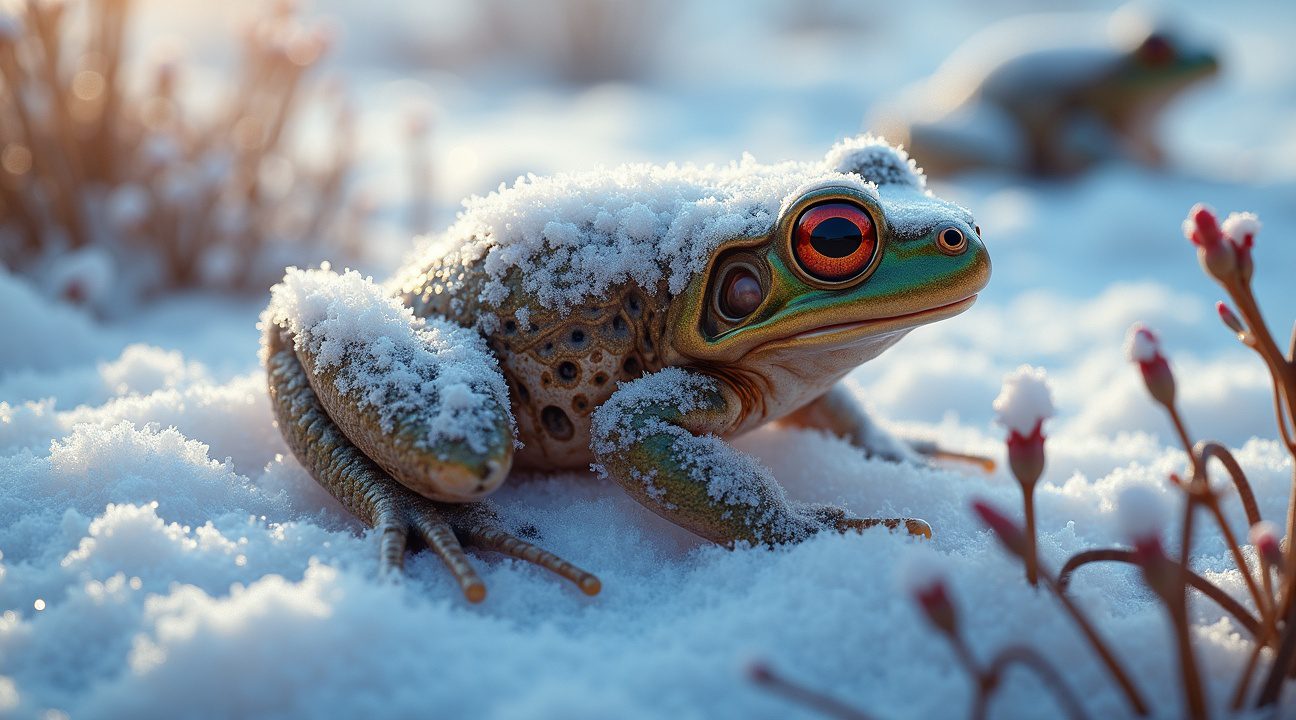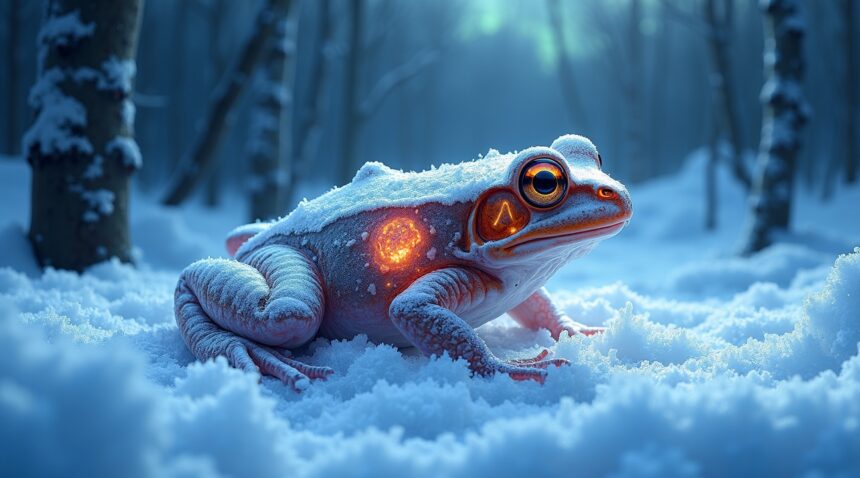The Alaskan wood frog achieves a phenomenon once thought impossible for vertebrates—complete biological shutdown for up to seven months, surviving with no heartbeat, respiration, or brain activity, only to reawaken come springtime.
Key Takeaways
- Complete biological shutdown: Alaskan wood frogs stop all vital functions including heartbeat, breathing, and brain activity for an average of 193 days, with body temperatures dropping to −6.3°C (20.7°F).
- Natural antifreeze production: These frogs flood their cells with glucose, urea, and glycerol before freezing. These compounds act as cryoprotectants that prevent lethal intracellular ice formation while preserving cellular structure.
- Perfect survival record: Research tracking individual frogs across multiple winters revealed a 100% survival rate. Every monitored frog revived each spring without signs of cellular damage.
- Enhanced regional adaptations: Alaskan populations show superior cold tolerance compared to southern wood frogs. They endure temperatures as low as −18°C (0°F) for extended periods, unlike their southern cousins who tolerate only brief, milder freezing.
- Medical research potential: Scientists are exploring the frog’s suspended animation biology to inspire advancements in organ preservation, surgery, and critical-care procedures involving induced hypothermia.
To explore more about how frogs like these inspire medical science, see this Nature article on frog hibernation and its biomedical applications.
How This “Biological Miracle” Defies Death for Seven Months
The Alaskan wood frog performs what scientists consider one of nature’s most extraordinary feats of survival. From September through spring, these remarkable amphibians enter a state of suspended animation that lasts up to seven months, enduring conditions that would prove fatal to virtually any other vertebrate.
The Complete Shutdown of Life Functions
During Alaska’s harsh winter months, wood frogs undergo a transformation that pushes the boundaries of what we typically consider possible for complex life forms. As temperatures plummet to –18°C (0°F) or lower, these frogs don’t simply slow down—they essentially shut off entirely. Their hearts stop beating completely, breathing ceases, and all muscle movement halts. Blood circulation ends, and scientists can detect no measurable brain activity whatsoever.
The physical transformation proves equally dramatic. Between 60 and 70 percent of the frog’s body water converts to ice crystals, turning the once-flexible amphibian into what researchers describe as a lifeless “lump of hard, frigid, icy stone carved in the shape of a frog.” This isn’t hibernation in the traditional sense—it’s biological death by every measurable standard, except for one crucial detail: the frog will return to life.
Research reveals that these creatures maintain their frozen state for an average of 193 days, with body temperatures dropping to an average of −6.3°C (20.7°F). The precision of this freeze-tolerance mechanism challenges our fundamental understanding of cellular survival. Ice formation typically destroys living tissue by puncturing cell membranes and disrupting vital cellular structures, yet wood frogs have evolved sophisticated biochemical defenses against this cellular destruction.
The key lies in their ability to produce natural antifreeze compounds, primarily glucose and glycerol, which flood their cells before freezing begins. These cryoprotectants don’t prevent ice formation entirely but rather control where and how ice crystals develop. Ice forms primarily in the spaces between cells rather than within them, protecting the delicate cellular machinery from damage. Additionally, the high concentration of glucose acts like a biological preservative, maintaining cellular integrity during the months-long frozen period.
What makes this process even more remarkable is its reversibility. When spring temperatures rise, the thawing process begins gradually. Heart function returns first, followed by breathing, and eventually full mobility. The entire revival sequence can take several hours to complete, during which the frog slowly transitions from a frozen state back to normal biological function.
This freeze-tolerance adaptation represents millions of years of evolutionary refinement. Other extraordinary survival mechanisms in nature pale in comparison to this seasonal death-and-resurrection cycle. The wood frog’s ability to survive complete cardiovascular and respiratory shutdown for nearly two-thirds of the year provides invaluable insights for medical research, particularly in fields like organ preservation and suspended animation techniques.
Scientists continue studying these biological miracles to understand how such extreme survival mechanisms evolved and function. The wood frog’s freeze-tolerance offers potential applications for human medicine, including:
- Improved methods for preserving organs for transplantation
- Developing treatments for hypothermia and other cold-related trauma
- Enhancing cryogenic storage techniques for medical and research use
Each spring, as these seemingly lifeless creatures emerge from their icy tombs and resume normal activity, they demonstrate that the line between life and death isn’t as absolute as once believed.
https://www.youtube.com/watch?v=gbRUMmQJq0U
The Body’s Natural Antifreeze Factory Kicks Into High Gear
When temperatures begin to plummet, the Alaskan wood frog’s body initiates one of nature’s most extraordinary biochemical transformations. I’ve studied how these remarkable amphibians essentially become living laboratories for cold survival, producing their own antifreeze cocktail that would make any chemist envious.
Glucose Production Goes Into Overdrive
The liver becomes the command center for this survival operation, rapidly converting stored glycogen into massive amounts of glucose. This isn’t just a minor metabolic adjustment – tissue glucose levels skyrocket to approximately ten times their normal concentration. Such extreme glucose production would be fatal to most animals, but for these frogs, it’s literally a matter of life and death.
Alongside glucose, the frogs accumulate high concentrations of urea and glycerol, both serving as powerful cryoprotectants. While most animals excrete urine as waste, these adaptive creatures retain it in their bloodstream where it mixes with glucose to create biological antifreeze. This retention strategy completely redefines how we think about waste management in living organisms.
Superior Cold-Weather Biochemistry
Alaskan wood frogs have evolved significantly enhanced biochemical machinery compared to their temperate cousins. Research shows they maintain much larger liver glycogen reserves, ensuring they can produce sufficient glucose when freezing begins. Their enzyme activity levels also exceed those found in warmer-climate relatives, allowing for rapid biochemical conversions when time is critical.
The combination of glucose, urea, and glycerol creates a sophisticated defense system against cellular destruction. These cryoprotectants prevent intracellular ice formation – the primary killer during freezing – while maintaining proper cell hydration through osmotic balance. Without this biochemical arsenal, ice crystals would puncture cell membranes and cause irreversible damage.
Scientists have discovered that cellular transformation in these frogs rivals some of the most advanced adaptations found in nature. The glucose concentration becomes so high that it fundamentally alters the physical properties of cellular fluid, lowering the freezing point and creating a syrup-like consistency that protects vital structures.
This antifreeze factory doesn’t operate randomly – it responds precisely to environmental cues. As autumn temperatures drop, enzyme systems activate in perfect sequence, ensuring maximum cryoprotectant production occurs exactly when needed. The timing proves critical because premature activation wastes energy, while delayed response means certain death.
The biochemical adaptations extend beyond simple antifreeze production. These frogs have developed enhanced membrane stability, allowing cells to withstand dramatic volume changes during freeze-thaw cycles. Their cellular machinery can function effectively even when surrounded by concentrated glucose and urea solutions that would denature proteins in other species.
Interestingly, research into these building blocks of survival has revealed applications far beyond amphibian biology. Understanding how wood frogs manufacture and deploy cryoprotectants offers insights into organ preservation, space exploration, and medical treatments requiring controlled hypothermia.
The glucose-urea-glycerol trinity represents one of nature’s most elegant solutions to extreme environmental challenges. Each component serves multiple protective functions while working synergistically with the others:
- Glucose provides immediate freeze protection and energy storage.
- Urea enhances osmotic balance and protein stability.
- Glycerol offers additional membrane protection and flexibility.
What makes Alaskan populations particularly fascinating is their enhanced capacity for this biochemical transformation. Generations of extreme cold exposure have selected for individuals with superior antifreeze production capabilities, creating populations that can survive temperatures that would kill their southern relatives. This represents evolution in action, demonstrating how species adapt their internal chemistry to match environmental demands.
https://www.youtube.com/watch?v=A7E6DRxs4D8

Surviving What Would Kill Any Other Animal
Wood frogs endure conditions that would instantly kill virtually any other vertebrate on Earth. I’ve studied countless examples of animal adaptation, but nothing compares to watching these remarkable amphibians survive 10–15 freeze-thaw cycles before settling into their prolonged winter hibernation. Each cycle represents a complete shutdown and restart of their biological systems – an impossible feat for most creatures.
The secret lies in their extraordinary cellular protection mechanisms. Most animals die when ice crystals form inside their cells, puncturing cellular walls and destroying vital organs. Wood frogs have evolved sophisticated adaptations that prevent this cellular destruction entirely. Their bodies produce massive amounts of glucose and urea, which act as natural antifreeze compounds. These cryoprotectants draw water out of cells before it can freeze, concentrating the ice formation in spaces between cells where it can’t cause fatal damage.
Unmatched Survival Statistics
Research conducted over two years using radio transmitters revealed the true extent of their survival capabilities. Scientists tracked individual frogs through multiple winter seasons, monitoring their locations and conditions throughout the freezing period. The results were astounding – not a single monitored frog died during overwintering. This 100% survival rate demonstrates an adaptation so refined that it borders on the miraculous.
The study’s findings become even more impressive when considering the harsh conditions these frogs face. Temperatures drop well below freezing for months, and the animals remain completely motionless with no detectable life signs. Their hearts stop beating, breathing ceases entirely, and brain activity becomes undetectable. Yet every single tracked individual emerged alive and healthy when spring temperatures returned.
Comparing wood frogs to other freeze-tolerant species highlights their exceptional abilities:
- Japanese tree frog: Survives brief freezing periods, but only for short durations and in much milder conditions.
- Siberian salamander: Demonstrates impressive cold tolerance, yet maintains some metabolic activity during winter dormancy.
- Wood frogs: Surpass both species in the duration and severity of freezing they can withstand.
The prolonged nature of their freezing sets them apart from all other known freeze-tolerant animals. While other species might survive a few days or weeks of freezing, wood frogs remain solid ice for up to seven months. During this time, their bodies contain up to 65% ice by volume – a concentration that would be instantly fatal to any other vertebrate.
Their adaptation proves so effective that researchers struggle to find any physiological limits to their freezing tolerance. Laboratory studies have subjected wood frogs to temperatures as low as -18°F (-28°C) for extended periods, and the animals continue to survive and recover completely. Scientists find building blocks for life in the most extreme environments, yet wood frogs have mastered survival in conditions that would challenge even the hardiest microorganisms.
The cellular mechanics involve rapid dehydration as temperatures drop. Water rushes out of cells and into intercellular spaces where specialized proteins guide ice crystal formation into harmless shapes. Simultaneously, glucose production increases by up to 100 times normal levels, flooding cells with protective compounds. This process happens so quickly that ice formation occurs in a controlled, non-destructive pattern.
Recovery presents another marvel of biological engineering. As spring warmth returns, the thawing process reverses the winter shutdown with precision timing:
- Hearts resume beating within hours
- Respiratory function reactivates
- Brain activity restarts without any signs of lasting damage
The frogs typically show no signs of cellular damage or cognitive impairment from their months-long suspension of life. Footage of giant squid might capture our imagination, but wood frogs demonstrate nature’s most incredible survival strategy right in North American forests.
https://www.youtube.com/watch?v=EkdP5T0uJcY

The Mysterious Spring Awakening Process
Spring arrives in Alaska with a remarkable transformation that defies conventional understanding of life and death. As temperatures climb above freezing, Alaskan wood frogs begin their extraordinary journey back from what appears to be complete biological shutdown. Their hearts start beating again, neural pathways reactivate, and circulation gradually resumes throughout previously frozen tissues.
The Sequential Revival of Biological Functions
The thawing process follows a precise sequence that scientists continue to study. Blood flow returns first to vital organs, followed by the gradual restoration of muscle function and nervous system activity. Unlike other hibernating animals that maintain some level of metabolic activity, these frogs literally return from a state indistinguishable from death. Their cellular machinery restarts without apparent damage, suggesting highly sophisticated protective mechanisms that operate at the molecular level.
Temperature plays the primary role in triggering revival, yet researchers haven’t identified the exact biological signal that coordinates this complex process. Some evidence points to glucose concentration changes as temperatures rise, while other studies suggest membrane stability factors initiate the awakening sequence. What’s certain is that multiple freeze-thaw cycles don’t diminish their revival capabilities, demonstrating remarkable cellular resilience.
From Frozen State to Active Breeding
The transition from frozen dormancy to active life happens with surprising efficiency. Within hours of thawing, wood frogs can move purposefully and begin seeking mates. Their breeding season starts almost immediately after revival, indicating that reproductive systems remain fully functional despite months of complete inactivity. This rapid transition suggests that critical biological processes remain primed for action even during the frozen state.
Living above the Arctic Circle presents unique challenges that these frogs have mastered through evolutionary adaptation. Their post-ice age migration patterns reveal a species that has thrived in extreme conditions for thousands of years. Modern climate variations that would devastate other amphibians barely affect wood frog populations, highlighting their exceptional adaptability to temperature extremes.
Recovery rates vary slightly between individual frogs, but most achieve full functionality within 24 hours of thawing. Some frogs demonstrate remarkable escape abilities from winter shelters that have shifted during freeze-thaw cycles. Others show immediate territorial behaviors, suggesting that memory and learned behaviors survive the frozen period intact.
The Arctic Circle environment that shapes their annual cycle creates conditions found nowhere else on Earth. These frogs experience temperature swings that would kill most vertebrates, yet they emerge each spring ready to reproduce and feed. Their ability to transition seamlessly from complete biological shutdown to active breeding represents one of nature’s most impressive survival strategies.
Scientists studying this revival process have discovered that cellular damage, typically associated with freezing and thawing, remains minimal in wood frogs. Protective compounds accumulated before freezing appear to shield cellular structures from ice crystal formation damage. Advanced imaging techniques reveal that even delicate neural connections remain intact after months of being frozen solid.
The mystery deepens when considering that these frogs don’t gradually slow down before freezing like other cold-adapted animals. They maintain normal activity levels until temperatures drop below freezing, then rapidly enter their suspended state. This suggests an on-off switch mechanism rather than a gradual transition, though the exact trigger remains unknown.
Research into their awakening process could revolutionize medical approaches to organ preservation and trauma treatment. Understanding how wood frogs restart complex biological systems after complete shutdown offers insights into cellular protection and revival that could benefit human medicine. Their natural ability to survive what amounts to temporary death challenges fundamental assumptions about the limits of biological resilience.
Each spring’s awakening proves that life can pause completely and resume without consequence, at least for these remarkable amphibians. Their consistent success rate in revival demonstrates that this isn’t a desperate survival gamble but a refined biological strategy perfected over millennia of Arctic survival.

Regional Superpowers: Why Alaskan Frogs Are the Ultimate Survivors
I find the geographic differences in wood frog survival abilities absolutely fascinating. Alaskan wood frogs possess extraordinary cold tolerance that surpasses their southern relatives by remarkable margins. These northern champions can withstand temperatures plummeting to –18°C (0°F) while remaining completely frozen for an astounding 7–8 months each year.
Geographic Adaptations That Defy Nature
Southern wood frog populations experience a completely different winter reality. Their cold tolerance operates within a much narrower range, typically handling temperatures between –2°C and –6°C (28–21°F). Many southern frogs don’t even freeze during winter months, instead relying on less extreme survival strategies like burrowing deeper or finding warmer microhabitats.
The physiological adaptations found in Alaskan populations represent evolutionary mastery that scientists are still working to fully understand. These frogs have developed enhanced antifreeze protein production, more efficient glucose distribution systems, and superior cellular protection mechanisms. Each adaptation works in concert to create a biological system that transforms the frog’s body into a state of suspended animation.
Alaskan wood frogs also demonstrate superior water management capabilities compared to their warmer-climate cousins. They can reduce cellular water content more effectively and redistribute fluids to prevent catastrophic ice crystal formation. This process requires precise timing and cellular coordination that southern populations simply haven’t needed to develop to the same degree.
The extended freezing duration sets Alaskan frogs apart from virtually all other vertebrates on Earth. While some fish and reptiles can survive brief freezing periods, few vertebrates maintain frozen states for more than a few weeks. Scientists studying these remarkable creatures continue discovering new aspects of their survival mechanisms.
These regional differences position Alaskan wood frogs as exceptional research subjects for medical and scientific applications. Their enhanced adaptations provide insights into cellular preservation, organ protection during extreme stress, and potential applications for human medicine. Researchers are particularly interested in how these frogs prevent cellular damage during the freezing and thawing cycles that would prove fatal to most vertebrates.
Temperature gradients across their range have created distinct populations with varying survival capabilities. Frogs from intermediate latitudes show moderate adaptations, creating a fascinating spectrum of cold tolerance that correlates directly with their local winter conditions. This natural variation provides scientists with multiple comparison points for understanding how these adaptations evolved and function.
The metabolic shutdown achieved by Alaskan populations exceeds what southern frogs experience during their winter dormancy. Complete cessation of brain activity for months at a time requires cellular protection mechanisms that southern populations haven’t fully developed. Heart function stops entirely, breathing ceases completely, and yet cellular integrity remains intact throughout these extended periods.
Alaskan wood frogs have essentially mastered biological time travel, putting their entire existence on pause for more than half the year. Their southern counterparts might slow down metabolically, but they maintain some level of biological activity throughout winter. This fundamental difference in survival strategy represents millions of years of evolutionary refinement specific to extreme northern conditions.
Research applications stemming from these regional differences continue expanding as scientists uncover new aspects of their cold tolerance mechanisms. Studies comparing regional populations reveal how environmental pressures shape biological capabilities over time. The enhanced adaptations found in Alaskan frogs provide blueprints for understanding extreme survival strategies that could revolutionize approaches to organ preservation, medical procedures requiring temporary life suspension, and even space exploration challenges.
These remarkable regional variations demonstrate nature’s incredible ability to fine-tune survival mechanisms based on environmental demands. Alaskan wood frogs represent the pinnacle of vertebrate cold adaptation, making them invaluable subjects for ongoing scientific research and potential medical breakthroughs.
What Scientists Hope to Learn From Nature’s Frozen Miracles
I find the Alaskan wood frog’s survival strategy fascinating because it offers groundbreaking insights that could revolutionize modern medicine. Scientists are intensively studying these remarkable amphibians to unlock the secrets of suspended animation, potentially transforming how we approach human healthcare challenges.
Medical Breakthroughs Through Frozen Biology
Medical researchers are particularly excited about applications in organ preservation and surgical procedures. The wood frog’s ability to halt all metabolic processes while maintaining cellular integrity could extend organ viability for transplants far beyond current timeframes. Current preservation methods keep organs viable for only hours, but understanding the frog’s natural antifreeze proteins and cellular protection mechanisms might allow storage for days or even weeks.
Suspended animation research represents another frontier where these frogs could change everything. Scientists envision applying similar principles to help patients survive catastrophic injuries or undergo complex surgeries that require extended periods without circulation. The frog’s natural ability to protect vital organs during complete metabolic shutdown provides a biological blueprint for medical applications that seemed like science fiction just decades ago.
Beyond immediate medical applications, researchers are examining how extraordinary biological adaptations might help humans survive extreme conditions during space travel or emergency situations.
Climate change research adds another crucial dimension to wood frog studies. As global temperatures shift and weather patterns become more unpredictable, scientists want to understand how these frogs might adapt their freezing strategies. Some populations already show genetic variations in their antifreeze protein production and cold tolerance thresholds, suggesting evolutionary flexibility that could help them survive changing conditions.
I’m particularly intrigued by the genetic variation studies occurring across different wood frog populations. Researchers are comparing frogs from various geographic regions to identify which genetic traits contribute most to freezing survival. These investigations reveal how evolution fine-tunes survival mechanisms across different environments, providing insights into both evolutionary biology and potential genetic therapies.
The implications extend beyond the frogs themselves. Understanding their genetic adaptability helps scientists predict how other species might respond to environmental changes. This research contributes to broader conservation efforts and helps us prepare for the biological consequences of our changing planet.
Each discovery about these remarkable creatures brings us closer to medical innovations that could save countless lives while simultaneously deepening our understanding of life’s incredible adaptability in extreme conditions.
Sources:
Los Angeles Times: “In Alaska, wood frogs freeze for seven months, thaw and hop away”
IFLScience: “How Do Wood Frogs Survive Freezing Solid In Winter … Meet the Real-Life Frogsicle That Can Survive Freezing”
Wikipedia: “Wood frog”
Audubon: “Frogs Freeze to Survive the Alaskan Winter”
National Park Service: “Wood Frog | Biological Miracle”
Nature Center at Shaker Lakes: “Frozen Frogs”
Yale Peabody Museum: “Frozen Frogs and Climate Change”


